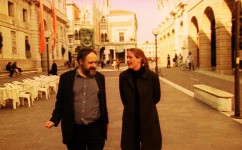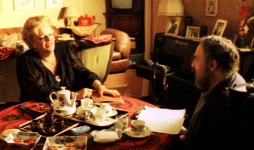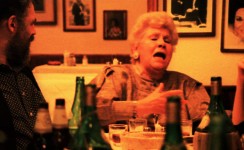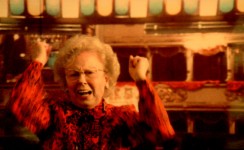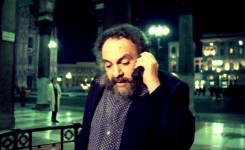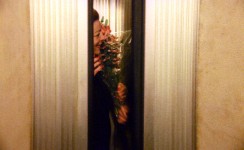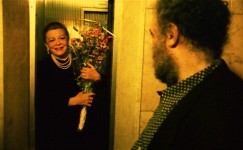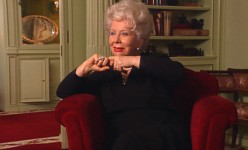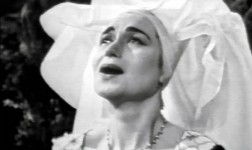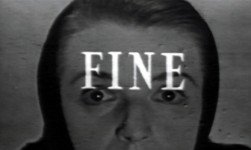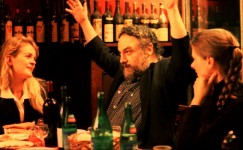Opera Fanatic
Facts
Opera Roadmovie, 93 min, 1999Directed by Jan Schmidt-Garre
A journey into the guts of the Italian opera of the fifties. Stefan Zucker, the "world’s highest tenor", an excentric opera fanatic from New York, visits the opera divas of his childhood: Magda Olivero, Anita Cerquetti, Giulietta Simionato, Leyla Gencer... The journey from apartment to apartment, from diva to diva, from Rome via Florence, Bologna, Padua, and Bergamo to the Scala in Milan, turns into an opera road movie.
With:
Iris Adami-Corradetti
Fedora Barbieri
Anita Cerquetti
Gina Cigna
Gigliola Frazzoni
Carla Gavazzi
Leyla Gencer
Magda Olivero
Marcella Pobbe
Giulietta Simionato
and Stefan Zucker
Cinematography: Wedigo von Schultzendorff
Editor: Gaby Kull-Neujahr
Co-produced by ZDF/3sat, YLE, NRK and SF
Supported by MfG and Media II
Press
Lee Milazzo, American Record Guide
Virtually every opera lover has heard Fedora Barbieri, Giulietta Simionato, Leyla Gencer, and Magda Olivero; but precious few have actually seen these great singers. So Stefan Zucker, in a van loaded with video cameras and tape recorders, plus an expert staff, criss-crossed Italy to interview not only them, but also Anita Cerquetti, Gina Cigna, Iris Adami Corradetti, Carla Gavazzi, Marcella Pobbe, and Gigliola Frazzoni.
The result is a riveting portrait of these singers as they are today – some still amazingly vital and active (Olivero, Barbieri, Simionato), some frail (Cigna, who managed to describe the importance of breath, and Corradetti, who died last year, making this only footage of her even more valuable), some unaffected and down to earth (Barbieri and Gavazzi), some still divas (Gencer agreed to be interviewed only at La Scala, and Pobbe acceded only after three attempts and then still proved to be very difficult). Interspersed are brief film clips and “sound bites” that allow us to see and hear them as they were yesterday.
Always armed with an appropriate gift, usually flowers or sweets, Zucker drew from his subjects a wide variety of opinions even as he concentrated on two themes, the decline of expressive singing in the present and the employment of the chest voice in the past. “Never” use the latter, insisted Barbieri, offering a revealing example from Falstaff; Simionato agreed. Nonsense, countered Gavazzi, insisting that they all fell into that practice. On a different matter, Gencer says she immersed herself so totally in a role that she wept on stage. Simionato, who says she would not become a singer if she had her life to live again, emphasizes creating beautiful legato – and when she demonstrates, you are carried back 40 years. Olivero performs the monolog from Adriana Lecouvreur and bursts into song at the conclusion, proving that at 88 she is still a more commanding artist than sopranos half her age.
Of course, a few shreds of gossip enliven the proceedings, such as Simionato’s statement that she had enemies who kept her in small roles for years, or Pobbe’s initial desire to discuss her affair with Nicolai Gedda and her later refusal to speak about it on camera, or Barbieri’s dismissal of a particular sexual stereotype. Don’t think that this brief summary has covered everything in the tape.
Richard Dyer, The Boston Globe
“Opera Fanatic” is a videotape presenting divas of the past in interviews with the opera fanatic himself, Stefan Zucker, tenor (“the world's highest”, according to the Guinness Book of World Records), entrepreneur, radio personality, and raconteur.
Director Jan Schmidt-Garre intercuts the interviews to stress thematic links and weaves in film clips showing singers in charismatic action. Divas will be divas; all of these women have presence, command and emanations – even frail Gina Cigna, interviewed at age 96 – and some of them show flashes of temper too. There is something indomitable and irresistible about all of these women; they are all opera fanatics themselves, but they also led real lives that gave them something to sing about.
Statement of the "Golden Prague" jury
This film, at the same time delightful and infuriating, superficial and profound, manages to introduce us to an amazing array of Italy’s legendary opera divas through the eyes of a real opera fanatic.
From the Jury statement of the Munich International Documentary Film Festival
Ten Divas and a tenor – a full load of eccentricity and vanity. The search for the secret of the chest voice is a road movie that will delight opera lovers as well as the general public. A homage to 1950s opera with imagery that proves that some documentaries are meant for the big screen.
aus der Begründung der Jury beim Internationalen Dokumentarfilmfestival München
Zehn Diven und ein Tenor – eine geballte Ladung Skurrilität und Eitelkeit. Die Suche nach dem Geheimnis der Bruststimme wird zu einem Roadmovie, das nicht nur Opernfreunde begeistert. Jan Schmidt-Garre vertraut auf die Exzentrität der alten Damen und setzt ihnen mit dem Tenor Stefan Zucker einen Experten gegenüber, dessen Originalität zu einem großen Teil das Vergnügen an diesem Film ausmacht. Erzählt wird diese Hommage an die Oper der 50er Jahre mit Bildern, die beweisen, daß der Dokumentarfilm auch im Kino seinen Platz hat.
William R. Braun, Opera News
So you’re planning your next slumber party. (And don’t give me that – you know who you are.) Along with the avocado facial and the Häagen-Dazs, you’ll be wanting this video.
Filmmaker Jan Schmidt-Garre has assembled a collage of interviews with ten divas (mostly Italians, plus the Turkish Leyla Gencer), and the results are never less than striking. Gencer, Gigliola Frazzoni and Iris Adami Corradetti all insist they cried onstage, especially as Butterfly. Giulietta Simionato, who looks smashing, tells us, "You don’t get a personality by studying." Magda Olivero, probably eighty-six years old at the time, performs the monologue from Adriana Lecouvreur. (Schmidt-Garre undercuts the moment halfway through with a distancing shot of the room.) A frighteningly frail Gina Cigna laments that opera has lost "spontaneity, beauty and freedom." At this point, you’ll probably need to answer the door, because Frazzoni is obviously a party girl (she sings and dances along with her video of La Fanciulla del West), and she looks as if she sent you a strip-o-gram and charged it to your credit card.
There is an extraneous Roger and Me device involving the repeated attempts of interviewer Stefan Zucker (himself a noted divo) to arrange some of these sessions. Gencer will only be interviewed at La Scala. Anita Cerquetti is embarrassed by her loudmouth, sluttishly dressed daughter. The "Roger" is Marcella Pobbe, who, when she finally works Zucker in around her hairdresser appointments, doesn’t like the questions because they aren’t entirely about her. But the film leaves camp behind in a haunting final sequence, as night falls and the interview with Carla Gavazzi goes on far longer than planned. Her career was sadly cut short by illness and family crises, but she is generous toward her colleagues and remarkably specific and practical about singing.
The Gavazzi sequence alone makes this film worthwhile, but there is also valuable footage of seven of the divas in some of their famous roles. Unplug the phone before you put this tape on, so you, like Pobbe, can say, "I didn’t make mistakes."
Hal de Becker, Las Vegas Weekly
Opera Fanatic: Stefan and the Divas provides 93 fascinating minutes with ten prima donnas, all former stars of operatic stages from La Scala to the Met. Interviewed in 1996 at their homes in Italy, the artists share their private and professional lives as well as their wisdom and singing voices with Stefan Zucker, publisher of Opera Fanatic magazine. Their demonstrations and discussions of vocal technique could be master classes. Some of the divas are in their 80s and, particularly Magda Olivero and Giulietta Simionato, still possess impressive voices. But in film clips from their heyday they are sublime. Zucker’s knowledge and humor are responsible for much of the video’s success, and, as the divas talk about rivals, roles and critics, there’s plenty of temperament. (Marcella Pobbe is asked which singers have impressed her most and she recoiled at the very idea of mentioning anyone's singing but her own.)
John Shulson, The Virginia Gazette
I’ve long ago given up Christmas lists for the arts-inclined. There’s just so much out there that it’s hard to cover adequately the possibilities. However, I just received a video from the Bel Canto Society and, after having watched it, couldn’t stop thinking of the people I know who would get a kick out of seeing it.
Thus, I share with you a few specifics. The delightful video is called "Opera Fanatic: Stefan and the Divas" and finds Stefan Zucker, a tenor, writer, editor, and broadcaster, interviewing such divas of the past as Marcella Pobbe, Giulietta Simionato, Carla Gavazzi, Fedora Barbieri, and Magda Olivero. The absolutely delightful interviews cover the divas’ views concerning careers in singing, singing techniques, and the world of opera. And it allows a glimpse of diva-dom.
Beyond the dialogue, some of which is rather risque, there are also many moments of historical operatic excerpts, among them Gavazzi in "Tosca," Simionato in "Samson," Barbieri in "Falstaff," and Olivero in "Adriana." Plus there are some great vocals that take place over dinner and wine.
Zucker is great fun to watch and hear. If you're an opera fan and appreciate divas, you might give this a Christmas thought or two. It also comes with a 32-page booklet.
Peter Krutsch, Leipziger Volkszeitung
Nearly fifty years after their triumphant period, Stefan Zucker went on a trip to the divas of his childhood. From Rome to Florence to Bergamo the risque New York intellectual visited the wonderfully eccentric prima donnas in their homes overflowing with memories.
The result is an opera road-movie full of theatricality and entertaining extravagance. With clashing colors and surging romantic music, director Jan Schmidt-Garre paints the picture of a forgotten epic, with obsessive people, extreme feelings and radical views. An ironic love-filled bow before loquacious elegance, bitchy entrances and heartfelt warmth of the decadent yet vital ladies. A handkiss of a film with a twinkle in the eye.
"Music is what I’m most interested in. It’s more important to me than film. But film also is a way to deal with music." Happily for the public, despite six years of music study, Schmidt-Garre decided in favor of celluloid instead of instruments. But the old passion for music colors even his sixth production, Opera Fanatic, which the Leipzig Passage Cinema presented at the documentary festival. Classical music is the great leitmotif that connects the work of the Munich-based director. He studied with Sergiu Celibidache and made two films about him, Celibidache: You Don’t Do Anything, You Just Let It Evolve and Sergiu Celibidache in St. Florian. He also made The Tenors of the 78 Era, which was so successful that ARTE recently rebroadcast it.
As part of the preparation for that series, the director was in New York where he came upon Zucker, listed in the Guinness Book of World Records as "the world’s highest tenor." Zucker is "a funny, very intelligent fellow" with an amazing voice. A sensitive opera lover, Zucker undertook this trip into the lion’s lair with empathy and delicate irony. The onlooker laughs so hard that he cries when with his eunuch-like voice Zucker tickles the vanity of the old ladies with searching questions about their sex lives. Their voices are weaker today but their diva pride is unbroken. According to Schmidt-Garre, "He and they are the two elements that make up the film. The lasciviousness is integral to opera, which suffers if one merely understands it rationally."
With "Opera Fanatic," Schmidt-Garre opens a new and different avenue not only to an art form but to an almost forgotten way of living. Opera is a subject often seen as leaden. This film makes it accessible through a healthy mix of reverence and irony.
Alan Blyth, Gramophone
Essential viewing for opera fanatics with a leaning towards the great sopranos and mezzos of the post-war years
This bizarre but fascinating film is well worth watching for the glimpses it gives us of some of the leading ltalian-based sopranos and mezzos of the 1950s and 1960s, both in action at the time and then interviewed at their homes by the zany opera fanatic Stefan Zucker, who is also seen and heard discussing with his film crew and helpers the whys and wherefores of great singing, particularly as it relates to those taking part. Eldest of the group is the 96-year-old Cigna, frail but still with her wits about her. Olivero, also in her 90s, has much – not unexpectedly – to say about her art. So does the perfectly groomed and coiffured Simionato, in her late 80s but not looking a day over 65, and reminiscing with firmness and charm. Barbieri is enormous fun and even entertains a dinner party with a song, Pobbe rather grand and difficult (on film impressive in a duet with Barbieri from Adriana Lecouvreur).
Most persuasive of all is the much-underrated Turkish soprano, Leyla Gencer, encountered singing the Trovatore Leonora’s Act I aria from a 1957 film of the opera. The poise and magnetism of her presence is felt both in her singing and speaking. (Zucker declares she is the only interviewee he has ever found to be erotic!). Her voice expresses all Leonora’s yearning in classically etched tones. A real discovery is the little-known and diminutive soprano Carla Gavazzi, caught on film as a moving Santuzza. All the artists emphasize that what they miss in singing today is expressive colouring and attention to the meaning of the text, both to create character. How right, in most instances, they are.
Imagine traveling through Italy with stopovers to meet the great prima donnas of the past. In 1996 this dream came true for the ebullient founder and editor of the magazine Opera Fanatic, Stefan Zucker, whose interview-visits with ten retired divas are documented on this video.
He comes across as an astute communicator, especially when discussing the singers with the Munich film crew. Director Jan Schmidt-Garre shoots with two cameras, one for the interview proper, the other capturing priceless behind-the-scenes moments that remove these stars from their pedestals and show their down-to-earth and vulnerable personalities.
First up is the legendary Anita Cerquetti, who had an amazing vocal instrument: a true dramatic soprano with a perfectly even scale, a large and brilliant sound, and agility. Getting down to work, as she puts it, Cerquetti sings a phrase from Norma illustrating three different moments of expressivity. "I sing it with my voice of today. Yesterday I would have sung it better," she apologizes, though her feeling for the words is shattering.
After three attempts, the interview with Marcella Pobbe finally takes place. The quintessential prima donna, Pobbe dictates how the interview should begin, saying: "I made myself available to you, so please do it." When asked what she would do differently if she could go back and begin her career anew, she replies: "Nothing. All I did was right....I didn’t make mistakes." When Zucker implies that after one season at the Met she did not return because of a love affair with one of the company’s leading tenors, she avoids the gossipy subject and simply states that Rudolf Bing broke the contract. During a break in the interview she asks one of the director’s assistants, "Why does [Zucker] ask such stupid questions?...The highest note, the lowest note, my breathing..." In a pair of excerpts from her 1955 film of Adriana Leconvreur one gets a glimpse of Pobbe’s striking beauty and interpretive refinement.
The outspoken Fedora Barbieri, who had retired only a year before this interview (after a fifty-five-year career), demonstrates a bit of her Mistress Quickly; her voice sounds exactly as it did when she sang her Met Falstaffs in the 1960s and 1970s. When Zucker asks the feisty diva to comment on the alleged lascivious carnal appetites of mezzo-sopranos, her response is, "You ask questions that are too difficult. I'm going to spank you!" Later, at a gathering in a restaurant with the entire film crew, Barbieri flirts with her interviewer, sings a Neapolitan song for him, and then predicts: "You’ll see that none of your other interviewees will sing!"
Magda Olivero, at age eighty-six, performs the Phaedra monologue from Adriana Lecouvreur, and a very frail Gina Cigna is on screen for barely a minute. Although Cigna cannot recall the year of her debut (it was in 1927), she is alert and succinct in describing her dissatisfaction with the current state of opera. In her last interview Iris Adami Corradetti (1903-1998) sings snippets of her Cio-Cio-San in steady tones. Carla Gavazzi, interviewed at an outdoor cafe, stops traffic while demonstrating various ways of singing "Amami, Alfredo!" and then adds a self-critique: "My vocal cords are perfect even now. I could still sing." The visit to Gigliola Frazzoni shows the soprano acting and singing along with a video clip from her own 1956 film of Fanciulla as it plays on her television screen; at its conclusion Zucker tenderly kisses the former Minnie.
The most illuminating interview takes place inside the Teatro alla Scala with Leyla Gencer. Clips of "Ritorna vincitor" from her intense Aida at the Verona Arena in 1966 are shown. Gencer, who always felt that if she couldn’t sing at La Scala she wouldn’t sing at all, reveals: "I was very ambitious. Either I have a great career or none." And she admits, with a mischievous laugh, "Yes, once in a while a note would issue forth that was not orthodox."
Asked about chest voice, mezzo Giulietta Simionato denies ever using it and demonstrates with an excerpt from her Azucena sung high and on the breath (even though in performance she sang the phrase in chest voice). Interestingly, Barbieri also vehemently denies singing chest voice, as do some of the sopranos Zucker interviews. Gencer skeptically observes, "This from [singers] who all their lives used chest voice; apparently they all have short memories!" while Gavazzi flatly insists that chest voice is "indispensable!" The video ends with three excerpts from Gavazzi’s 1956 film of Cavalleria rusticana.
After analyzing the answers to his favorite question posed to the divas ("What are the different aspects of expressive singing?"), Zucker concludes that their expression was intuitive.
The tape comes with an informative thirty-two-page booklet that includes biographies of all the singers interviewed, the name of Pobbe’s Met lover, Barbieri’s diatribe against Simionato, and Cerquetti’s explanation for her premature retirement. Some of the rare film sequences on this video haven’t been seen in over forty years. This is a video that you will want to watch repeatedly to relive the memories of these great artists of the twentieth century.
Robert Prag, The Opera Quarterly
1. When I heard Cerquetti sing a group of arias in her only New York recital (Carnegie Hall, 26 October 1958), her voice showed no signs of wear, even though her brief career was coming to an end. She retired from singing in 1960, when she was only thirty years old.
2. Pobbe sang three performances at the Old Met in March 1958. She had a radiantly beautiful lyric soprano voice, silvery pianissimos, and a bright upper register.
3. I heard plenty of those "unorthodox" notes in Gencer’s performance in Attila; her high notes were explosive, and she tore up the scenery with her acting. However, in Caterina Cornaro, a bel canto opera that suited her to perfection, she floated some lovely pianissimos and displayed an even legato and a solid top register.
4. At her Met performances of Trovatore Simionato sang the phrase in chest voice. Her Amneris and Santuzza also included chest-voice tones. Only as Rosina in Barbiere did I hear her sing low notes high and on the breath.
Opernwelt April 1999, Dieter David Scholz
Geheimnisse des "Canto espressivo" – Jan Schmidt-Garre bittet zehn Diven von gestern vor die Kamera
Wer die Geheimnisse des "canto espressivo" lüften will, der muß sich an die Diven von einst wenden, denn nur sie können Auskunft geben über Belcanto alter Schule und das "Singen aus den Eingeweiden", das heute nahezu ausgestorben ist. Das sagte sich auch der Opernfreak, Autor und Regisseur Jan Schmidt-Garre und schickte ein ganzes Team nach Italien, die Spuren der großen Primadonnen von gestern und vorgestern zu suchen und sie noch einmal vor die Kamera zu locken und sie zu befragen nach dem, was Gesangskunst ausmacht. Daß Schmidt-Garre die kauzige New Yorker Kultfigur (jedenfalls einer gewissen Szene) Stefan Zucker, nach eigenem Bekunden "der höchste Tenor der Welt", tatsächlich ein kleiner, dicker, alles andere als attraktiver Mann mit schwer erträglicher Fistelstimme und nicht eben virilem Gebaren, über den Brenner schickt, gen Rom, dem Ausgangspunkt einer so bewegenden wie interessanten Spurensuche, nimmt dem Film leider jenes Quentchen, das ihm zur wirklichen Größe hätte gereichen können. Der Film ist zwar für den, der sich für das Thema interessiert und der über die Stimme und Erscheinung Zuckers hinweghören bzw. -sehen kann, trotz Zucker eine großartige Dokumentation, aber doch mit einem Wermutstropfen eingetrübt. Nicht, daß es Stefan Zucker an Sachkenntnis, Beherrschung der italienischen Sprache und Geschick des Fragens mangelte, aber er wirkt, mit Verlaub gesagt, doch eher grotesk, als daß er als seriöser Gesprächspartner der zweifellos großen Persönlichkeiten, denen er gegenübersitzt, ernstzunehmen wäre. Zuckers "Tuntigkeit" verleiht dem Film den Hautgout dessen, was Wayne Koestenbaum (in seinem Buch "Königin der Nacht") "schrillen Camp-Stil" nennt. Vieleicht ist dies eine Reverenz Schmidt-Garres an das Zielpublikum seines Films. Auch der beliebige, nichtssagende, ja geradezu in die Irre führende Titel "Opera Fanatic" scheint vor allem auf ein spezielles New Yorker Publikum zu zielen. Schade, denn der Film enthält sehens- und hörenswerte Interviews, wertvolle historische Ton- und Filmdokumente in selten zu sehenden Ausschnitten, er stellt intelligente Fragen und gibt aufschlußreiche Antworten. Er ist darüber hinaus atmosphärisch dicht, schon die nostalgischen Fünfziger-Jahre-Farben, in denen er gedreht ist, verzaubern. Auch die Einbeziehung einer Rahmenhandlung mit Straßenfahrten in einem Chevrolet-Van durch Mailand, Florenz, Bologna, Padua und Rom, die Tankstellensequenzen und Lagebesprechungen in Treppenhäusern, Interviewvorbereitungen wie auch Geschenkkäufe und Telefonate mit den Diven ist orginell und verleiht dem Film aufregende Authentizität. Auch die Gegenüberstellungen der verschiedenen Divenantworten mit schnellen Schnitt- und Bildfolgen. geben dem Film animiertes Tempo, das durch die stimmungsvoll ruhigen Bilder nostalgischer "Italianità" einen schönen Pulsschlag bekommt. Was die zehn höchst unterschiedlichen Sängerinnen angeht, die noch einmal vor der Kamera zitiert werden, mit mehr und weniger großem Aufwand: es sind Kabinettstücke und Kostbarkeiten darunter, die man nicht vergessen wird. Anita Cerquetti etwa, die vor dem Interview erst einmal ihre temperamentvolle Tochter verjagen muß. Sie erläutert das Geheimnis des "canto espressivo" mit dem gesten- und mimikintensiven Hinweis darauf, daß man eben wissen müsse, mit wem man singe, wovon man singe und wofür man singe. Dann finde man schon Ausdruck und Farbe. Leyla Gencer, die sich partout nur in einer Loge der Scala filmen läßt, hat nur Spott übrig für steriles und akkurates Singen, das sei "Musik mit Wasser und Seife". Die Mezzosopranistin Fedora Barbieri, die sich vehement gegen den Einsatz Bruststimme ausspricht und bestechende Beispiele ihrer stimmlichen Möglichkeiten vorführt, droht dem Interviewer mehrfach angsteinflößend, ihn zu verhauen, als er sie nach den Anfechtungen des Fleisches und anderen persönlichen Dingen fragt. Wie ungeniert und impulsiv sie sich beim angeheiterten Abendessen mit dem Filmteam in einer Trattoria gebärdet, darf als schönste Bestätigung italienischer Mentalität aufgefaßt werden, die dem ganzen Film eine sinnlich-heitere Aura verleiht. Marcella Pobbe, die man eindrucksvoll in einem Adriana-Film erleben darf und alle paar Minuten ihr Kostüm wechselt, in ihrer Miniatur-Wohnung posiert und Fragen diktiert, bestätigt hingegen Primadonnen-Vorurteile. Rührend ist die Begegnung mit der greisen Gina Cigna, die zitternd vom Zwerchfell als der Seele und dem Atem als der Basis allen Gesangs spricht.
Magda Olivero, die unangefochtene Diva des veristischen Belcanto (man sieht sie in einem großen Filmausschnitt als überwältigende Tosca), beeindruckt durch ihre Klugheit und Ernsthaftigkeit des Redens über Gesangskunst, aber auch durch die nach wie vor Gesänsehaut erregende Darbietung einer Kostprobe aus "Adriana Lecouvreur". Ihr Credo: Es komme nicht nur auf Schöngesang an, sondern vor allem auf den "Gesang der Seele", das Singen von innen. Auch die Simionato, die, ganz Grand Dame, in schwarem Kostüm, dreifacher Perlenkette, hinreißender Frisur in rotem Sessel thront, pflichtet der Olivero bei. Singen sei eine Auszeichnung, eine Gnade, aber auch der Gebrauch eines Instruments, das nicht nur nach optimaler Technik verlange, sondern zur Wahrhaftigkeit verpflichte. Sie stellt übrigens stimmlich imposant ihre sängerische Autorität unter Beweis, indem sie Legatogesang und Einsatz der Stütze demonstriert. Die Simionato ist die einzige der zehn Opernstars der dreißiger bis siebziger Jahre, die sich offen zu den Kehr- und Schattenseiten einer so hoch angesiedelten Sängerinnenexistenz bekennt. Nicht noch einmal, sagt sie, würde sie diesen Beruf ergreifen! Nachdem sie zwanzig Jahre unbemerkt auf der Reservebank der Mailänder Scala gesessen habe, hätte man sie nach ihrer Entdeckung regelrecht ausgepreßt, bis sie keine Luft mehr bekommen habe. Ein Leben auf Flughäfen, in Hotels und Theatern. Was für ein aufrichtiges Bekenntnis. Zugegeben: Vergleicht man die zehn Primadonnen des Films mit den heutigen Gesangstars der internationalen Opernszene, wünscht man sich zurück in Zeiten, in denen es noch solche singenden Persönlichkeiten auf der Opernbühne gab! Insofern darf man diesen nostalgischen Blick zurück durchaus als einzufordernde Utopie eines Nicht-mehr- und Noch-nicht-Auffassen: Erinnerung beleuchtet Gegenwart.
Awards
Munich International Documentary Festival
Golden Prague (Czech Crystal)
Additional
Poster "Opera Fanatic"
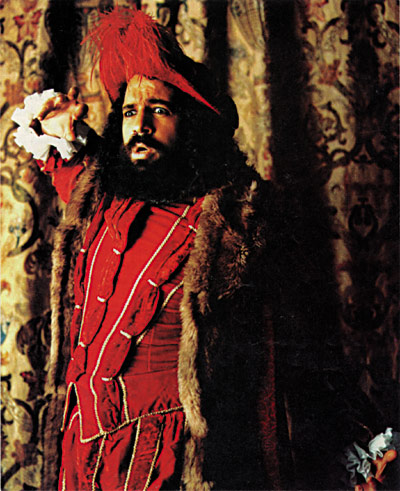
Quotes
Giulietta Simionato
"Today personality doesn’t exist. Either they don’t know what it is, or they don’t have the courage. ‘I understand what you’re saying, students tell me, but I don’t know how to do it.’"
Magda Olivero
"If one just sings, without putting in any heart or soul, it remains just beautiful singing, and not a soul that sings!"
Stefan Zucker
"We live in the age of Barbie Doll opera – singers who move well and look good but express little. We need hair under the arms singers."
Releases
On DVD with Arthaus Musik: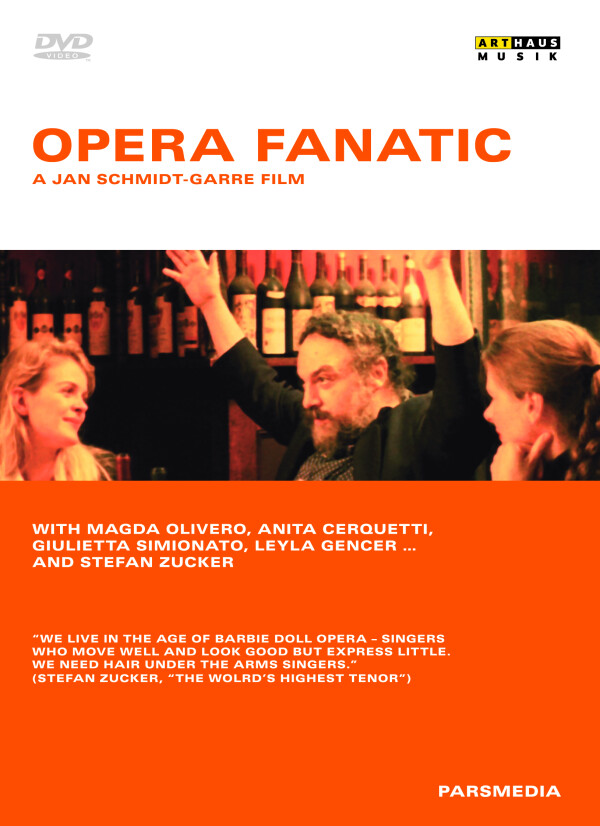
Texts
Documents and Artefacts
Presented at the IMZ and EBU workshop "On Making Documentaries about Music and Musicians"
by Jan Schmidt-Garre
We have been talking a great deal about music today and about the right way of staging music or musicians in a documentary. The word indicates that we are concerned here with documents, and I would like to develop a few thoughts on this subject: on the relationship between reality, depiction, and fiction, between the document and the artefact.
1. Document
The presence of the camera changes the object. Light, framing, camera movements, and later the selection and context rob the document of its innocence and convert it into an artefact that is determined by the medium and the author at least as much as by actual reality. "The medium is the message", as Marshall MacLuhan said. Is the pure, innocent document a fiction?
Example 1: Callas/Habanera
Sometimes, however, the message is the message. This single shot contains everything: musical theatre, the art of singing, identification, distance, irony, devotion. The power of this document protects it from being devoured by the voracious medium. Direct cinema. Cinéma vérité. This ideal may be naïve in terms of epistemology, but it is attainable in rare and fortunate cases, and it was with it that I approached my first major subject as a film-maker, the conductor Sergiu Celibidache. I accompanied him for three years to rehearsals, on concert tours, and to watch him teaching. How could the pictures we took of Celibidache achieve the directness and authenticity of the pure document? "It was an animal film", the cameraman said when filming was finished, and indeed we had lain in wait for a tiger in the jungle. Celibidache did not seem to notice we were there, and his vital self-confidence prevented him from changing by one iota from his normal self when the cameras were running. And the musicians who were playing under his baton were so much enthralled and challenged by his authority, that questions of shame or vanity simply never arose.
Example 2: Celibidache/Forza del destino
However, it is possible for a crack to appear in the self-contained system of Cinéma vérité if reality fails to stick to the agreement, which is: we observe you and you don't notice us. If the document suddenly looks at me, it catches me red-handed as a voyeur. It turns my own weapons against me and forces me into an uncomfortable intimacy, an intimacy that I had not asked for. Suddenly a window opens onto the actual reality behind that which is being depicted.
Example 3: Celibidache/Forza del destino/Glance into the camera
2. Artefact
My film "Bruckner’s Decision" also started as a documentary. A brief episode in Bruckner’s life had caught my interest, a time of crisis and transition. He had been sent to a water spa in 1867 on account of psychological problems. He spends the summer there and finally, at the age of 43, takes the existential decision to become a composer. Everything that follows flows from the decisiveness he has at last gained: his move to Vienna, his position as a professor of composition, and most particularly his powerful Masses and symphonies. I could not draw on any documentary film material from 1867 so I decided to use what is now called "dramatic reconstruction", and created my own artefacts. In the sound I combine these artefacts with authentic documents from Bruckner – letters –, and I complement and reflect them with letters from a fictitious person whom he meets at the spa – another artefact.
Example 4: Bruckner’s Decision/Bad Kreuzen
The film met with approval and objections, but there was one accusation that was never made, and for me this is the greatest compliment of all: my film was never accused of falling to pieces, of trying to combine too many disparate elements. In addition to the artefacts from Bruckner’s spa treatment there is also documentary material in it of a present-day Bavarian Corpus Christi procession, modern church-goers leaving after the service, Bruckner as a child in St. Florian, clouds, photographs from Mexico in the 1930s, and a painting by Manet. Bringing these heterogeneous elements together into one consistent whole was in my view the challenge of the editing-room, and it was here, as with all my films, that the creative work actually took place. The experience I have had of artists like Bruckner and Celibidache, and his teacher Furtwängler (about whom I am currently making a film essay), is constantly challenging me to look for a self-contained form in art, an art that does not naively avoid, let alone deny, the ugly, the disturbing, the destructive, but attempts to integrate it into a coherent whole. I defend this principle against the over-powerful tendency of our day to present a torso, a fragment, an open form. Every cut that I make in the editing-room is an attempt to re-create the innocence – reconstruction in the age of deconstruction. In the editing-room we played around with our artefacts and tried out different combinations, and suddenly, again, a window opened. Two shots that we had filmed independently of one another revealed themselves as a straight shot and its reverse angle. We see what Bruckner is seeing. We see with his eyes, we are suddenly inside his head. This creates identification and empathy. And that is how "Bruckner's Decision" turned into a feature film.
Example 5: Bruckner’s decision/glances
3. Artefacts from documents
"Belcanto" is a series about historic tenors, and came about not only because of my enthusiasm for these magnificent musicians but also because there are exciting documents available on the great singers from the early days of sound films that hardly anyone knows anymore these days. These documents are not immediately accessible; there is a layer of cultural dust on them that we first had to remove. This starts with the technical parameters; finding the original negatives from which we can make a tele-cine transfer and define the best possible framing, avoiding the cut-off heads, and finding the right running speeds – which can be anywhere between 18 and 24 frames per second – as this can after all affect not just the pitch but also the colour of the voice. However, more than this was at stake: we had to bring historical material to life. The old film documents had to be integrated as perfectly smoothly as if we had staged them today specially for our portraits. The material we were filming now, on the other hand – the atmospheric scenes and interviews with experts and eye witnesses, and so on – had to be brought close to the historical documents. So we filmed in black-and-white. We tried to bring all the components together into a flow of film. Historic locations such as the Teatro Colon in Buenos Aires or the Festspielhaus in Bayreuth were not filmed as dead pieces of architecture but as the backdrop to real live scenes. Photographs are not cut in as lifeless stills, but they appear in the hands of the people we are talking to, again, as parts of a scene being shot today. Symptoms of the past that you can analyse and categorise with polite interest turn into symbols that lead to an understanding and experience here and now, to real empathy. Staged situations for bringing historical material to life: artefacts from documents.
Example 6: Caruso/Little Italy
In "Belcanto" we worked to a strict pattern. We were involved in a 13-part series, so we had to take care of recognisability, of a clear graphic profile, and so on. At the same time, however, we tried not to lose sight of the need for just a little irritation, for those windows in the television screen or on the cinema screen through which actual reality flashes at occasional moments. We tried once again to create structures that were so stable that they could even still carry the moments of disparity without assimilating them in a "kitschy" way. There was such a moment in Ireland, in a meeting with the John McCormack Society. Elderly McCormack fans meet every Thursday for no other purpose than to listen to records together.
Example 7: McCormack/Society
The devoted glance of this lady, in my view, brings John McCormack, who died 57 years ago, back to life: his patriotism as an Irishman and his faith; but at the same time it shows what he still means to Irish people today – and how long ago it all is. But in return for that this shot has to be maintained for such an embarrassingly long time.
4. Documents from artefacts
Celibidache's glance into the camera had opened a window into the reality behind the documents of Cinéma vérité. This is, because a totally different picture is seen from the Divine point of view from the one we were filming: musicians with instruments and the conductor in front of them, yes, but also: spotlights, cables stuck together with tape, microphones, rails, cameras, technicians with headphones. Revealing this situation as it actually exists is the principle behind my film "Opera Fanatic".
Example 8: Monty Python/a film within a film
The idea behind "Opera Fanatic" came from outside: Stefan Zucker, a brillant New York opera expert and singer claiming to be listed in the Guinness Book of Records as the world’s highest tenor, was planning to go to Italy and interview the great female singers of the 1950s and 1960s. He asked me if I would like to join in. In order to get a clear picture of a project I like to place myself in the role of a doctor and break the development process down into the three phases of anamnesis, diagnosis, and therapy. The anamnesis starts with the initial idea: a subject, material, or as in this case a suggestion from outside. I start researching and building up a personal relationship with the material. Here, that consisted of listening to records of the singers, studying their biographies, their repertoires, and so on. This leads to the diagnosis. I try to recognise the material as such, to take hold of it. What kind of a project is this? Actually, in this case the interviews with the old ladies were actually only secondary; the real subject of the film was Stefan’s journey through Italy, his search for the great pathos of a long-vanished opera, his search for childhood memories, and perhaps even the search for his own mother, herself an opera singer of those days, who used to take him with her when she made guest appearances in Italy. Once the material has been diagnosed the therapy can start: how can this be realised in an adequate way? I decided to locate the film on two levels: Stefan’s travels through Italy in an old van, with all his expectations and comments, filmed with a hand-held camera on Super 16 mm, and in parallel with that the interviews with conventional lighting, the camera on a stand, shot on video. A film within a film, documents from artefacts.
Example 9: Opera Fanatic/Gencer
The only "true" side of the interview situation in Cinéma vérité terms is the interview situation itself, with all the cables, artificiality, and nervousness. How will Giulietta Simionato, whose apartment we have turned upside-down, react to Stefan Zucker, who is all a bit of a mystery to her and now asks her, in his castrato voice and affected Italian: "Let us assume we are in the 1930s and you are at the beginning of your career. What would you do different?" We see her sitting all amongst the cables and lamps, we see Stefan Zucker, the sound engineer, the video-cameraman, and we see the video-camera waiting for the answer. She needs a few seconds, and then: "I wouldn't do it again."
Example 10: Opera Fanatic/Simionato
This sentence, in this situation and after this pause for thought, comes fairly close to the ideal of the directness and authenticity of Cinéma vérité. But even here, again, it is not Giulietta Simionato as such who is speaking. There is no key-hole through which we can see her. But there is the actual Giulietta Simionato, here and now, in this situation, with this face that she is showing to us. And in order to understand this face I open the context out as wide as it will go and thus try to reach the limits of the observation situation. I unmask the documentary situation of the interview by documentary means as artificial: documents from artefacts. However, even in "Opera Fanatic", which so to speak institutionalises the open window and turns it into a principle, there is a moment when reality breaks in and bursts out of the framework of the film.
Example 11: Opera Fanatic/Pobbe
Is Marcella Pobbe being compromised here? Is Stefan Zucker being compromised? The question is connected to my subject because a document that is created without the knowledge of its protagonists has, in the nature of things, a greater potential for authenticity – if only of a somewhat negative kind. Every viewer will answer for himself the question as to whether "Opera Fanatic" exposes its heroes. I can only try to explain my attitude to those scurrilous, weird phenomena that keep turning up in my films. My attitude is determined by empathy and identification, and at the same time a sense of distance. This may sound like a paradox, and perhaps even perverse, but as I hope the films show it is possible. I like Stefan Zucker but at the same time I recognise very clearly what an impudence this man is. I identify myself with his obsessions, but that does not mean that they become mine. I never laugh at anyone but I welcome and provoke laughter. I think this attitude is camp. Camp is not ironic and not cynical; it is a broken and desperate yearning for authenticity that sometimes can only be achieved in this kind of strange indirect way.
5. The document recovered
Example 12: Monty Python/a film within a film within a film
Just as the tortoise kept ahead of the hare, reality always seems to be a step ahead of us. Not even exposing the observation situation releases us from this dilemma. There is always an irreducible rest left over, a "strange loop". A thousand veils, and no reality behind them as Lyotard says? There is one escape route, and this is art: somehow the absolute artefact. To put it in the words of the Romantics, "All one can actually do is write poetry – everything else is inexact." And the absolute document?
Let’s go back into the editing-room, whith the cans that came out of three years’ filming Celibidache. Here the trilogy of anamnesis – diagnosis – therapy is repeated. The first step is to gain the full acquaintance of the material, to assume ownership over it, to master it – this is the most laborious and unproductive part of film-making. I keep trying to shorten it, or delegate it to someone else, but it doesn’t work; the author himself, like a good doctor, has to go through this whole process. In the diagnosis the material is then recognised and evaluated: where in this unstructured continuum does a take start and end? What kind of a character does it have? Does it belong to the exposition? Or to the resolution? What is the inner dynamic of my material? The only virtues that help here are honesty – the material must be recognised and accepted for that which it is – and humility: I must not demand too much of the material, or force anything onto it of which it is not capable. I can and must work with that which is given, and not with unrealised intensions or prefabricated theories, I must not overrule or misuse my material. "Going on from the given" is Celibidache's definition of the legato, and for Furtwängler the highest aim for any musician is real legato playing. Interpretation, regardless of whether it is of musical or film documentary material, would then mean: recognising and realising the forces resident in the material. Just as good therapy can only be the kind that helps the body to heal itself. Each detail thus finds its position out of itself, and the film in its entirety takes on the force and necessity of an organically grown structure. Our document, having lost its virginity during the course of this long story of voyeurism, manipulation, and corruption, can regain a second innocence. The film then no longer needs any window onto actual reality because it has become a window itself, the icon through which reality reveals itself. Just as in Zen: "When we reach the ground and the origin, the mountain is once again a mountain and the river once again a river, the meadow is green and the flower is red."
"Opera Fanatic" – Interview
Jan Schmidt-Garre in conversation with Rebecca Fajnschnitt, December 1999
Your "Belcanto" series dealt with the tenors of the age of shellac. In "Opera Fanatic", the subject is Italian singers of the 1950s – is the new film a continuation of the series on the tenors?
It is more a satirical postlude to the series. After dealing with the aesthetic phenomenon of bel canto in a serious, almost scientific way, as I consider it represents the central point of singing, I felt a desire to concern myself with the periphery, with the coarse and grubby aspects of singing and opera. And, after all those short portraits, I felt like returning to the cinematic form of the documentary film.
In contrast to the series, in this case there is an interlocutor between the singers and the audience, who is unmistakably asking his own, highly personal questions: Stefan Zucker. Is he the opera fan, the "Opera Fanatic"?
Perhaps not the actual "Opera Fanatic" as such to whom the film is addressed, but in any case an extreme example of this type. I met Stefan Zucker while shooting the Caruso episode for “Belcanto” in New York. It was initially very difficult to contact him because he never answered the phone or the letters we wrote him. When I finally reached him, our first telephone conversation lasted three hours. He is one of these extroverted yet shy people, like Glenn Gould, who love the phone. I interviewed him about Caruso’s place in the history of singing since the invention of the high C. The interview was extremely unusual and bizarre, but also quite fascinating. So we met again and did more interviews, and Stefan suggested a project to me that he had been dreaming of for years: to visit the great ‘verismo’ divas of the 1950s whom he had listened to as a child, when his mother, who was also a singer, was touring Italy.
So it was all his idea?
His idea was simply a series of interviews with legendary singers such as Anita Cerquetti, Magda Olivero, or Giulietta Simionato on singing, and he wanted me to produce and direct it. I told him that the project would only interest me if I could film it as an entity: the journey of this eccentric New York intellectual through Italy, from one diva to another, with his comments on the meetings, his expectations, and so on. The interviews were to be his films, so to speak, and I would film the ‘making’ of it.
Is that why you shot on two different film stocks?
Yes. The journey through Italy was filmed on Super 16 and the interviews on video. In order to emphasize the contrast even more, we filmed the interviews with a tripod, with soft lighting and classic composition, but we filmed the rest with a hand-held camera and used a technical process that produces high grain and extreme colors. This was intended to evoke the look and the colors of the 1950s and 1960s, such as in the films of Rosselini and Visconti, the era when these singers were stars, so that we had two levels and a strong contrast between then and their lives now in present-day Italy.
A third level is created by the exerpts from historical opera films, all veristic operas (except for Verdi): Cavalleria, Tosca, Adriana...
I love these operas and enjoy playing with with the poor taste they are accused of having. Composers such as Mascagni, Cilea, Zandonai, and to a certain extent Puccini, had the bad luck to become prominent and popular in an era which is now regarded almost exclusively as one of revolutionary discoveries and changes. Looking back, music historians today only give credit to the innovative work of Debussy, Janacek, and Stravinsky, and regard the veristi – who considered themselves innovators, the giovane schuola, ‘young school’ – as the reactionary establishment. In terms of harmonic boldness, Mascagni can easily compete with his contemporaries; it is his pathos that is hard to take, which bothered the critics even back in 1915, and people today, in these pragmatic times, all the more so. But this pathos seems to me to be the main point: the divas made everything too big, too proud, too capricious, they made emotions superhuman. The modern viewer would turn away in embarrassment and ask for a greater sense of distance.
On the other hand, Stefan Zucker seems to be interested in very carnal matters, and makes lewd remarks about the sex lives of mezzo-sopranos.
That is the opposite pole. Stefan’s obsession with gossip and sex represents the crude, vulgar, fairground dimension which opera has always had and which has been blanked out by modern intellectualisation and purification. This stretches right down to the singing style; Stefan misses the ordinary breast voice nowadays, the direct, crude expression which our divas were able to use, even if most of them do not actually admit it in the film. In his opinion, singers today model themselves on the ideal of instrumental music, instead of the rich possibilities of the human voice, from screaming and swearing to the high stylization of Bel canto. For a while we even wanted to call the film "Deep Throats", after the famous porn film, because this dimension belongs to opera just as much as etherealness – and humor!
Because you show the interviews with the singers as a film-inside-a-film, the viewer experiences the encounters as something very personal and seems to be getting a look behind the scenes. On the other hand, you show how artificial the context is in which they’re talking by showing the entire film crew and equipment set up in their homes.
What’s normal about the statement, taken out of the context of the interview situation, simply gives the illusion of directness. The context is absolutely artificial; the interviewee is sitting between cables and tripods with the light behind her and tries to react to unexpected questions gracefully, spontaneously and intelligently. The only ‘genuine’ aspect of this situation, if one would like to refer to the cinéma vérité goal of trying to capture the unvarnished truth, is the interview situation itself, with all the cables, all the artificiality, all the nervousness. How does Giulietta Simionato react to Stefan Zucker? We turned her home upside down, she cannot quite make head or tail of him, and he asks her in meticulous Italian and his castrato-like voice: "Let us assume that we are back in the 1930s and you are at the beginning of your career. What would you do differently?" You see her sitting there between the cables and the lamps, you see Stefan Zucker, the sound engineer, and you see the video camera waiting for her answer. She thinks for a moment and says: "I wouldn’t do it again". This sentence, in this situation and after this pause for thought, comes fairly close to the directness and authenticity cinéma vérité in the Sixties strove for. But I only get there by way of a detour. Taken out of its context, which I reveal, or to put it more honestly, the one I have artificially reconstructed with lighting, different stocks, and editing, this ‘true’ sentence would have been fake.
"Opera Fanatic" – Quotes
If one just sings, without putting in any heart or soul, it remains just beautiful singing, and not a soul that sings!
Magda Olivero
Today personality doesn’t exist. Either they don’t know what it is, or they don’t have the courage. “I understand what you’re saying,” pupils tell me, “but I don’t know how to do it.” And I say: But at a certain moment you say to your fiancé, “I love you”. You don’t have to say it melodrammatically like in theater, but you have to put something of your own into it. When you sing “My heart opens for you,” this is so sensual that it should be sung with a certain part of the body I dare not name. But it has to be like this!
Giulietta Simionato
I know of these magnetic emanations I have. When I’m on stage I say: "Now you have to feel as I do!"
Leyla Gencer
A singer cannot be compared to an actor. The singer has to sing. He has to stay motionless. When he sings a romance he can’t walk up and down the stage. Otherwise the voice shifts. The singer has to be an actor through his gestures, through his face, through his arms and hands. Through his voice! Expression is done through singing.
Anita Cerquetti
They say… – Tell me! – … that mezzos … – Here comes the lie. – … are more … – Lie! Boys, I know sopranos who are in bed from morning to night! Don’t talk of mezzos. The same with basses. – You think all singers have carnal appetites? – All. Don’t you? – Of course. I’m a tenor!
Fedora Barbieri and Stefan Zucker
